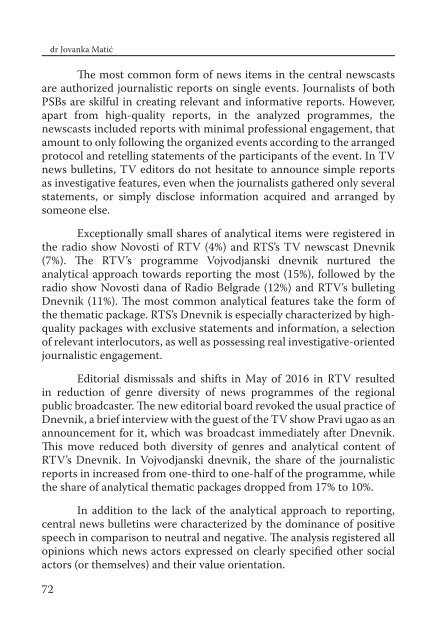You also want an ePaper? Increase the reach of your titles
YUMPU automatically turns print PDFs into web optimized ePapers that Google loves.
dr Jovanka Matić<br />
The most common form of news items in the central newscasts<br />
are authorized journalistic reports on single events. Journalists of both<br />
PSBs are skilful in creating relevant and informative reports. However,<br />
apart from high-quality reports, in the analyzed programmes, the<br />
newscasts included reports with minimal professional engagement, that<br />
amount to only following the organized events according to the arranged<br />
protocol and retelling statements of the participants of the event. In TV<br />
news bulletins, TV editors do not hesitate to announce simple reports<br />
as investigative features, even when the journalists gathered only several<br />
statements, or simply disclose information acquired and arranged by<br />
someone else.<br />
Exceptionally small shares of analytical items were registered in<br />
the radio show Novosti of RTV (4%) and RTS’s TV newscast Dnevnik<br />
(7%). The RTV’s programme Vojvodjanski dnevnik nurtured the<br />
analytical approach towards reporting the most (15%), followed by the<br />
radio show Novosti dana of Radio Belgrade (12%) and RTV’s bulleting<br />
Dnevnik (11%). The most common analytical features take the form of<br />
the thematic package. RTS’s Dnevnik is especially characterized by highquality<br />
packages with exclusive statements and information, a selection<br />
of relevant interlocutors, as well as possessing real investigative-oriented<br />
journalistic engagement.<br />
Editorial dismissals and shifts in May of 2016 in RTV resulted<br />
in reduction of genre diversity of news programmes of the regional<br />
public broadcaster. The new editorial board revoked the usual practice of<br />
Dnevnik, a brief interview with the guest of the TV show Pravi ugao as an<br />
announcement for it, which was broadcast immediately after Dnevnik.<br />
This move reduced both diversity of genres and analytical content of<br />
RTV’s Dnevnik. In Vojvodjanski dnevnik, the share of the journalistic<br />
reports in increased from one-third to one-half of the programme, while<br />
the share of analytical thematic packages dropped from 17% to 10%.<br />
In addition to the lack of the analytical approach to reporting,<br />
central news bulletins were characterized by the dominance of positive<br />
speech in comparison to neutral and negative. The analysis registered all<br />
opinions which news actors expressed on clearly specified other social<br />
actors (or themselves) and their value orientation.<br />
NEWS AND INFORMATION PROGRAMMING OF THE SERBIAN NATIONAL AND<br />
VOJVODINA REGIONAL PUBLIC SERVICE BROADCASTERS (RTS AND RTV)<br />
In RTS’s Dnevnik, news actors expressed a positive opinion on an<br />
actor relevant for the topic in 58% of the cases, negative in 22% and neutral<br />
in 16% (in 4% both positive and negative). Negative evaluations were<br />
mainly expressed by the election participants – the opposition parties<br />
about the current government’s results, and the representatives of the<br />
government on their political opponents. In Radio Belgrade’s newscast<br />
Novosti dana positive qualifications of other actors were recorded in 38%<br />
of cases, neutral in 31% and negative in 29% (in 2% combined).<br />
In RTV’s Dnevnik, 47% of the attitudes were positive, 25% neutral<br />
and 23% negative (5% both positive and negative). In Vojvodjanski<br />
dnevnik, positive value orientation of speech of the news actors prevailed<br />
with 53%, compared to 22% of neutral and 20% of negative (5% combined).<br />
After the editorial shift in RTV, the share of positive speech in this news<br />
bulletin increased from 51% to 58%. In the RTV’s radio programme, after<br />
a change of editorial orientation, the structure of actors’ attitudes was<br />
also modified, so the positive increased from 44% to 45% and negative<br />
were reduced from 21% to 15%.<br />
Mirror of the editorial policy<br />
Primetime news bulletins of the national and regional public<br />
broadcasters have a large and loyal audience. RTS’s TV programme<br />
Dnevnik is especially valued and is among the most watched programmes<br />
of this public broadcaster. However, the popularity of these programmes<br />
is not a proof of their quality.<br />
The analysis of the news items of central newscasts from the first<br />
half of 2016 – what they report, about whom and how they report –<br />
showed that, besides their undisputable qualities in professionalism of<br />
journalists and attractive presentation, these programmes also had some<br />
significant weaknesses. In their choice of topics covered, as well as the<br />
choice of actors representing certain activities and opinions, and the<br />
level of professional engagement of journalists, they did not reach the<br />
standards needed for the public service broadcasters to achieve their<br />
desired roles and influences.<br />
72 73


